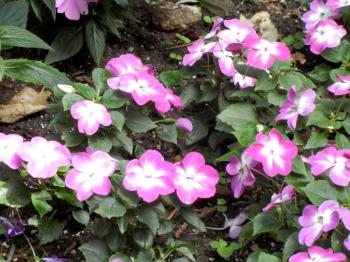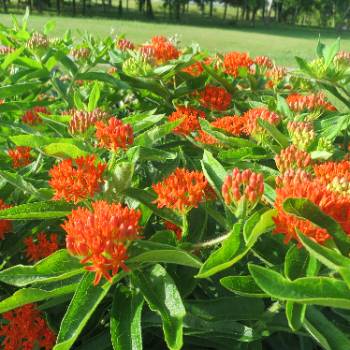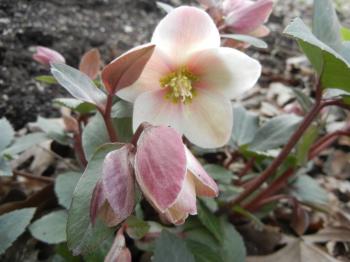Annuals and Perennials

What determines if a plant is called a perennial or an annual?
A plant that is sold as an annual is one that completes its life cycle in one season. Think of a impatien, marigold, or even a tomato plant. We plant them after all chances of frost have passed, then they grow during the warm months and die with a killing frost. These would be called warm season annuals—growing from start to finish basically from frost to frost, during the warmer months of the year. Pansies and violas, lettuce and radishes, would be considered cool season annuals, with planting dates either in the fall or late winter. They would die with the onset of hot weather.

A perennial is a plant that lives for more than one year. Some perennials like daylilies, asparagus and hosta die back completely to the ground after a killing frost in the fall, and begin new growth in the spring. Other perennials like hellebores (Lenten rose), rosemary and lambs ear are evergreen, but live from year to year. Some perennials are very long lived like peonies and ferns, while others are relatively short lived like dianthus and foxglove.
Most perennials are non-woody. They have a season of dormancy, and a few are evergreen. They have a season of bloom, bloom length can vary from 2 weeks to 4 months.
Depending on where you live and the average low winter temperature, or high summer temperature will determine whether the plant is an annual, perennial or evergreen. Annuals are often used to give you instant color with bedding plants, or as seasonal vegetables, while perennials may bloom a shorter period of time, but don't have to be replanted every season.
Annual and Perennial Flowers Add Flair
They are the icing on the cake of a landscape. When choosing color for your garden, make sure you have something blooming in every season.
Annuals are plants we need to replant every year, so you don’t want a yard that is all annuals, or you have to replace the entire garden twice a year. We have warm season annuals for summer color and cool season annuals for fall and winter color.
Plant your seasonal color in a concentrated block of color to make the biggest impact
in the garden. Consider entryways or other visible parts of the garden. Annuals
and perennials do
well in containers or planted in the ground.
Group plants together that need the same conditions—sun, water, and fertilizer needs. We don’t want to treat each plant individually but collectively as a garden.
Since annuals are only with us for one season, while we have them we need to fertilize frequently to keep them blooming. Water needs will vary from plant to plant, but all plants need water to get roots established. Perennials typically need less fertilizer than annuals, but more than trees and shrubs.
Some good choices for annual flowers include plants in the Arkansas Diamond program. A partnership between the Arkansas Green Industry Association, the University of Arkansas Cooperative Extension Service, local growers and independent garden centers the goal of the program is to educate Arkansas gardeners about annual plants that consistently perform well in our state.
For 2016 three new summer annuals have been added to the Arkansas Diamond program. The plants chosen are two sun lovers – ‘Graffiti Red’ pentas and ‘Sriracha Pink’ cuphea and the shade loving ‘Velvet Elvis’ plectranthus.
Don’t overlook the 2015 plants which include:
red dragonwing begonia, purple angelonia, Cora Cascade polka dot vinca, Redhead
coleus, blue scaevola and gold/yellow lantana.
Some additional shade annuals include:
- the wishbone flower
- torenia
- begonias
- impatiens
- coleus
And don’t forget tropical flowering plants. While some gardeners do overwinter them indoors to extend their life, they can also be planted in the garden and treated as summer annuals. From the pink blooming mandevilla to a wide range of tropical hibiscus blooms, they thrive on heat and humidity and provide plenty of seasonal color.
Perennial plants typically have a season of bloom and a season of green. Some bloom in the winter, some late winter to early spring, some for summer and others for fall bloom. Choose a variety to extend the bloom periods in your garden. Some great summer choices include the milkweeds –Asclepias tuberosa is the showy orange butterfly weed which blooms for months in the summer and is a great host plant for monarch butterflies. Echinacea or purple coneflower now comes in a wide range of colors and is a long‐season bloomer provided the blooms are dead‐headed after flowering. Hardy hibiscus love water and sunlight and bloom from June through August with dinner plate sized blooms in red, pink or white, and gaillardia or blanket flower gives you a sea of color all summer in the sun.
If you have shade try some hardy geraniums—they look nothing like the annual flowering plants, or heuchera (coral bells) with foliage in almost every color of the rainbow. Woodland poppies provide bright yellow flowers and while hostas are grown more for their foliage they do produce flower spikes—some larger and showier than others. So whether you have sun or shade, a large garden or a few containers, there are choices of flowering plants that fit. It all comes down to the right plant for the right place. A garden should change with every season, and diversity in a garden adds even more interest. From shrubs to trees to annuals and perennials there are so many plants to try. Evaluate your landscape and try to determine what season needs help with color and do your homework. If you have some holes to fill or you are building new beds, experiment with some different plants.
Perennials are plants that come back for more than one year, and often they come back larger each season, so give them room to grow.

Related Publications:
- Wildflowers - (Arkansas Living Article October 2016)
- Garden Planning 2016 - (Arkansas Democrat Gazette 2016)
- Tulips - (Arkansas Democrat Gazette December 2015)
- Pumpkins - (Arkansas Living Article October 2015)
- Everlastings
- Gourds
- Pansies
- Fall
- Bulbs
- Ferns
- Ornamental Grass